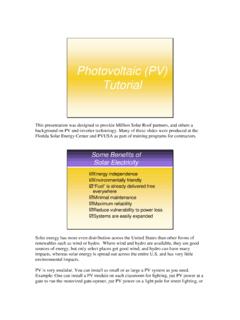Transcription of Solar Photovoltaic (PV) System Components
1 Az1742 May 2018 Solar Photovoltaic (PV) System ComponentsDr. Ed FranklinIntroductionSolar Photovoltaic (PV) energy systems are made up of different Components . Each component has a specific role. The type of component in the System depends on the type of System and the purpose. For example, a simple PV-direct System is composed of a Solar module or array (two or more modules wired together) and the load (energy-using device) it powers. The most common loads are submersible water pumps , and ventilation fans. A Solar energy System produces direct current (DC).
2 This is electricity which travels in one direction. The loads in a simple PV System also operate on direct current (DC). A stand-alone System with energy storage (a battery) will have more Components than a PV-direct System . This fact sheet will present the different Solar PV System Components and describe their use in the different types of Solar PV Module to LoadTo match the Solar module to the load, first determine the energy needs of the load. For example, a submersible fountain pump normally attached to a 12 volt battery can be powered using a Solar module. The battery provides a specific amount of power (measured in watts) to energize the pump.
3 Here, a pump operates on 12 volts DC, and amps (maximum) of electric current. The total power (watts) of the pump is found by multiplying the volts (12 V) by the amperage ( A). The total power is 30 watts. A module with the capacity of producing at least 12 volts is necessary to push the electrical current through the pump motor. Solar ModuleThe majority of Solar modules available on the market and used for residential and commercial Solar systems are silicon-crystalline. These modules consist of multiple strings of Solar cells, wired in series (positive to negative), and are mounted in an aluminum frame.
4 Each Solar cell is capable of producing volts. A 36-cell module is rated to produce 18 volts. Larger modules will have 60 or 72 cells in a frame. The size or area of the cell determines the amount of amperage. The larger the cell, the higher the 1. A 12 volt bilge pump works very well in a bucket wired to a Solar module. This module produces 17 volts DC and moves water very handily when exposed to the University of Arizona Cooperative ExtensionFigure 2. The Solar cell is the basic component. Cells wired together and mounted in a frame compose a Solar module. Several modules wired together form an of 3.
5 Examples of mono-crystalline (left) and poly-crystalline Solar PV modules. Mono-crystalline were first produced and used by NASA and the US military. Poly-crystalline are less expensive, and found world-wide on the renewable energy market. Early modules were mono-crystalline and had round cells. The manufacturing process resulted in a more efficient cell, but resulted in waste, and is an expensive process. Today s crystalline modules are poly-crystalline and are cut into square or rectangular-shaped cells. The process wastes less material, but produces a less efficient module.
6 However, decreased costs has made it a competitive ArrayThe Solar array is made up of multiple PV modules wired together. Connecting the negative (-) wire of one module to the positive (+) wire of a second module is the beginning of a series string. Wiring modules in series results in the voltage of each of the two modules is added together. For example, a 20-Source: NREL Source: Author Figure 4. Modules mounted together on racks and wired togther to create series strings. Arrays can be pole-mounted (left), ground-mounted (right). Roof-top arrays can be mounted using flat-roof rackinging, and pitched-roof mounting systems Source: Author Source: Nunutak Energy watt module rated at volts and amps is wired in series to second similar module.
7 The result is a series string capable of producing volts ( + = ). However, the current each module produces, stays the same. A series string represents the summed voltages of each individual module. Each module should be the same voltage and current. The negative cable of one module is connected to the positive cable of the next module. In a large System , multiple strings are assembled and the non-connected ends are connected to homerun leads which are landed at the terminals of an enclosure located near the array. For example, if an array is made up of a string of 10 modules, each rated at 30 volts and 4 amps, the string would be rated at producing 300 volts (10 x 30 volts) and 4 amps, or a total of 1,200 watts ( kW).
8 The goal is to wire modules in series to build voltage. Since the AC voltage in a residence operates on 120 to 240 volts, it is desirable to achieve the voltage necessary to operate the loads in the residenceCombiner BoxA PV System array with multiple strings of modules will have a positive lead and a negative lead on the end of each string. The positive leads will be connected to individual fuses and the negative leads will be connected to a negative busbar in an enclosure. This is called the source circuit. The combiner box serves to combine multiple series strings into one parallel circuit.
9 For example, an array with three strings of 10 modules wired in series would produce 300 volts (10 modules x 30 volts) per string and 4 amps per string. When the leads are landed in the combiner box, the circuit would produce 300 volts at 12 amps (3 strings x 4 amps/string). Once the circuits are combined, leaving the box it is referred to as the output circuit .3 The University of Arizona Cooperative ExtensionSource: AltE Store Source: WileySource: AuthorFigure 5. Examples of different size combiner boxes. The positive (+) lead is connected to the fuse. The negative (-) lead is connected to grounded buss bar.
10 The box on the left supports two strings. The box in the center supports four strings. The box on the right is a commercial-sized combiner box supporting several 6. Three strings of 10 PV modules, each rated at volts max power (Vmp) and Amps are wired in series. Each string has a total volts max power of 354 volts max power (Vmp) and Amps, (current, max power --- Imp). The positive (+) lead from each string is connected a fuse, and the three are connected to an output circuit. The negative (-) leads from the three series strings are landed onto a bus bar in the combiner box.













